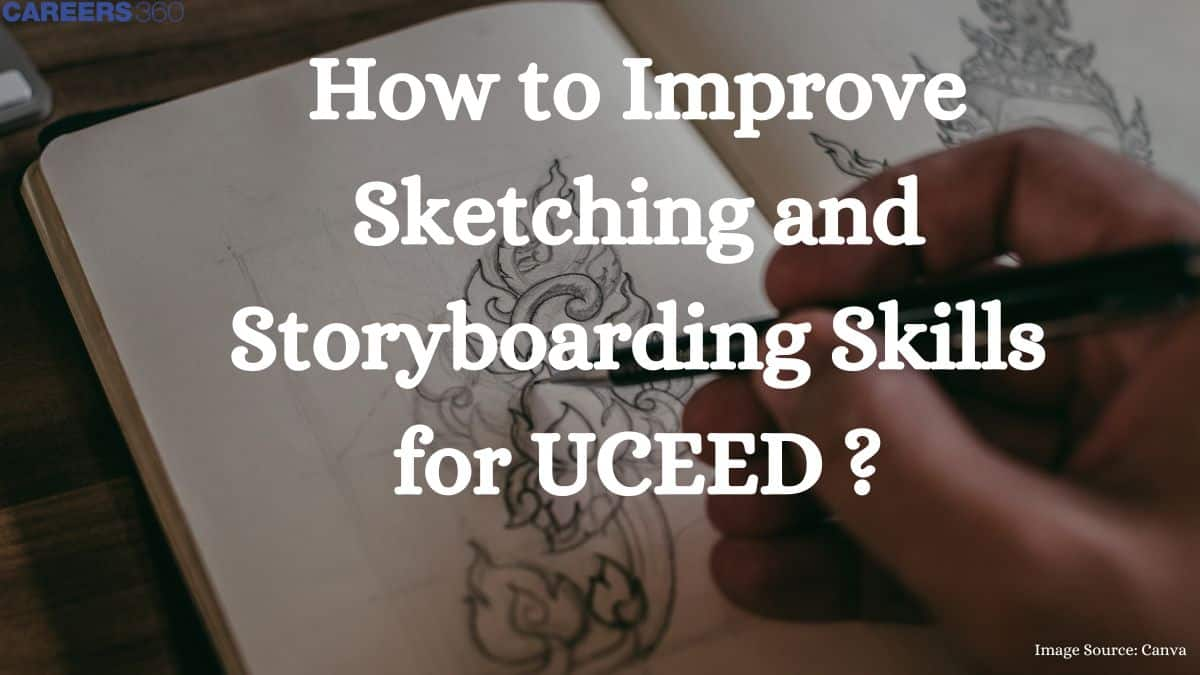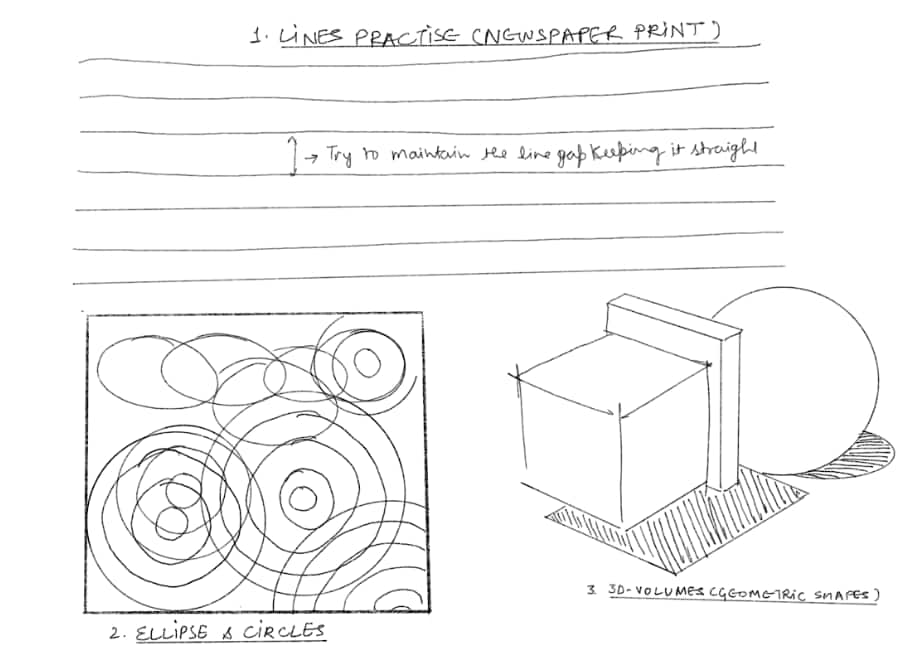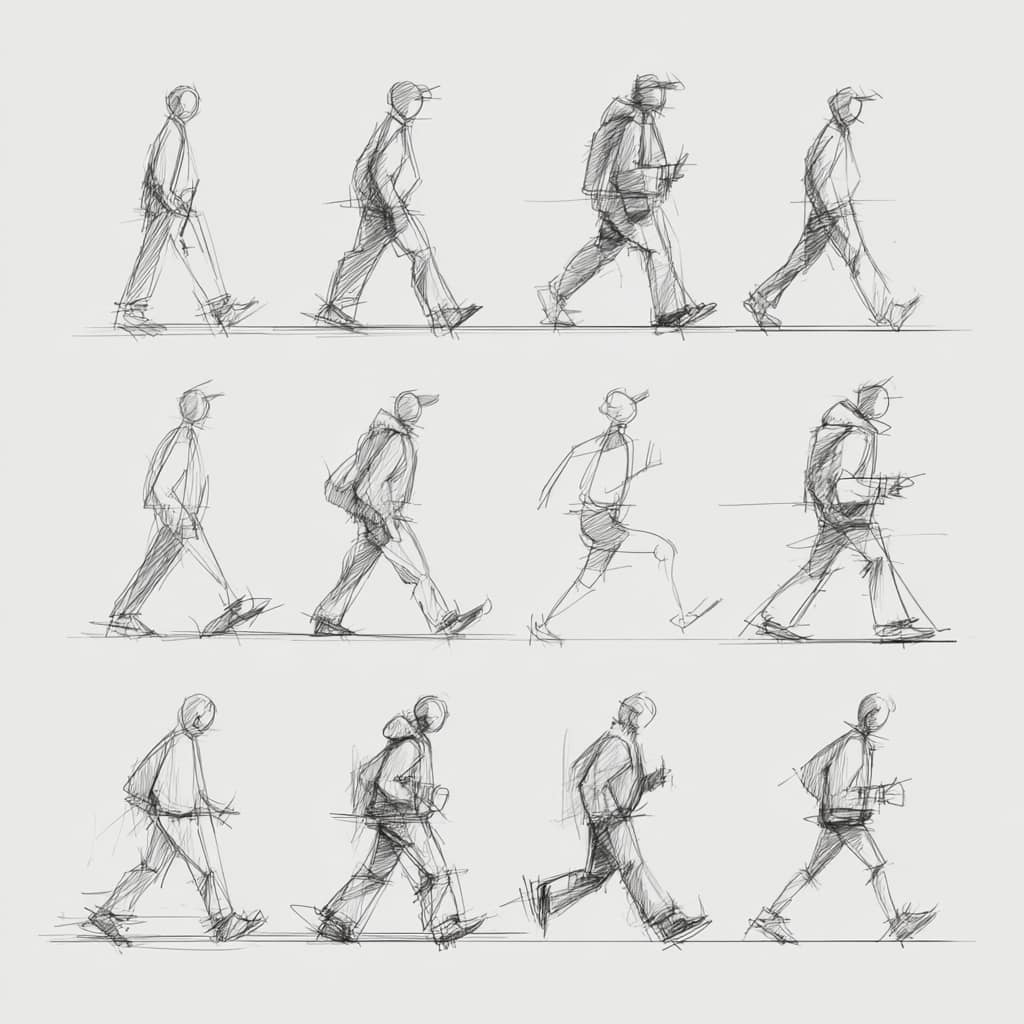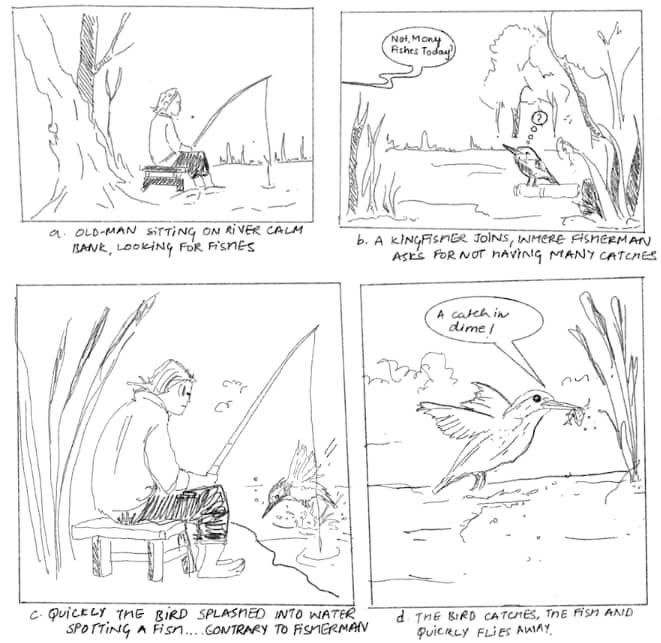UPES B.Des Admissions 2026
Ranked #45 amongst Universities in India by NIRF | Ranked #1 in Academic Reputation in India by QS World University Rankings
UCEED Admit Card Date:08 Jan' 26 - 08 Jan' 26
In order to succeed on the UCEED exam, prospective students must possess the "Visual Communication Skills," which include storyboarding and sketching ability. These are crucial skills for demonstrating your design ability and visual proficiency in the UCEED exam 2026. This article would be a helpful guide for applicants with ideas and tactics for taking the UCEED exam, as the drawing section of the test has become more significant in recent years. The UCEED 2026 exam is scheduled for January 18, 2026, according to the Indian Institutes of Technology.
This Story also Contains

Sketching is a designer’s first language, rapidly translating thoughts into tangible ideas, for showcasing the creative thinking. Sketching is a strong medium to communicate your creative potential, clarity and visualizing the concepts. As part of your UCEED preparation 2026 improving your sketching skills is essential to performing well in the exam.
Work on Line Quality: Develop a habit of sitting for long hours for sketching, with confidence. It is advised to use the arm, not just the wrist for confident strokes. Try exercising the continuous line, ellipses and straight lines on old newspapers exploring each 2D shape with different scales.
E.g. Try sketching the concentric circles on a newspaper through the arm, to vary the scale and understand the reference points.

Work on the basics of “Human-Anatomy, Postures, Walk and Run cycle”. The mentioned topics have frequently been asked in the various DAT Exams

Practice Composition and Layout: Composition is a mindful arrangement of the elements (e.g. fruits in a plate, where fruits are elements) in a 2D-plane like paper, to guide the viewer’s eye and create visually balanced, impactful images.
The UCEED 2026 exam pattern has been divided into two parts A and B with balanced weightage. As per UCEED, this section consists of 2 sketching questions, with 50 marks for each. This section has been added to UCEED entrance exam in recent years to test aspirants’ sketching and visualization abilities and is hence very important.
The sketching section evaluates student’s ability to sketch and present their ideas visually. It tests basic drawing skills, creativity, and how well candidates can represent concepts. Candidates are typically asked to draw objects, scenes, or even abstract concepts. The questions can vary from illustrating an object in different views, drawing a product design, or visualizing a given theme in a creative way.
The storyboarding section evaluates student’s ability to represent a sequence of events visually. It tests how well a candidate can communicate a story, concept, or sequence through a series of sketches. Questions are asked to create a storyboard for a simple narrative, such as depicting the steps of an action or an idea through a sequence of panels. The challenge is to represent the flow of events clearly and creatively.
Given below are tips and tricks students can use to ace the UCEED drawing questions.
Daily Sketching: Begin with the habit of carrying a sketchbook always and drawing your surroundings, will help you develop visual memory and hand-eye coordination in the initial stages of learning.
Timed Sketching: Timed sketching allows you to practice with speed and efficiency, which is essential for exams, now focusing on drawing aptitude with increased weightage on the Part B (Drawing Aptitude).
Leading Design College | Highest CTC: ₹12 LPA | Average CTC: ₹7.5 LPA | Scholarships for Deserving Students
NAAC A+ & NBA Accredited | QS I-Gauge Gold rated University | Scholarships available for Meritorious students | Application Deadline: 28th Feb’26
Observational Drawing: Drawing what you actually see like the object and associated with focus on texture, shadow, light source etc., to enhance your realistic, expressive rendering. Students are advised to go through Top 10 Common Drawing Tasks in UCEED & How to Practice Them.
Material Explorations: Experiment with different tools and develop your own techniques using pencil, pens and other sketching mediums like charcoal etc. Explore the line weight, texture and effects possible to develop your own style.
Learn by Copying(Learning by Seeing): Analyze and copy sketches from the reputed designer to understand different approaches to form line, and rendering. This is for learning.
Storyboarding skills are critical for designers, enabling them visualization of processes, user journeys and events of sequences. It is about telling a story, visually in a frame by frame manner as depicted below. In Design Aptitude exams, storyboards assess sequential thinking, user interaction understanding and clear narrative communication.
A storyboard is a visual narrative, in a logical frame-by-frame approach, illustrating the progression in actions, emotions or environmental changes. For story boarding we would be sharing a guide for helping you with the clear beginning, middle and end.
User Centric Approach : In design entrance exam the storyboards can be effective tool in following scenarios:
User Interaction with Product and Interaction : This helps in depicting the user’s experience, paint points and how design solutions address them.
Simplicity and Clarity : storyboards are quick communication, using simple clear sketches and minimal text. Avoid clutter that distracts from the core narrative
Define your story: Before jumping directly in, clarify yourself with the following:
Begin with Thumbnails: Start with small, rough sketches (thumbnails) for each frame to quickly experiment with compositions and flows.
Set Character and Environment: While making thumbnails, simple stick figures convey emotions and actions, a few lines suggest environments, focusing only the necessary context.
Annotations: Use brief notes, arrows, and speech/thought bubbles to support the actions and emotions in the given frame.
Practice Scenarios: Work through scenarios like a user encountering a problem, and your design solving it, or step-by-step product use. This helps in building a sequential and visual thinking. Practice UCEED previous year papers for structural understanding.
Let’s try to understand the Process of Storyboarding in a frame by frame manner and supporting visuals.
Also Read:
Old Rohan, the fisherman, threw his fishing line into the calm river. A bright kingfisher bird, named Kiki, landed close by, watching a shiny small fish. "Not many fish today, Kiki?" Rohan quietly said. Kiki made a short, happy sound, tipping its head as if it understood. "You need to wait patiently, small friend," Rohan told it, "and look carefully." Suddenly, Kiki quickly dove down and caught the small fish super fast. Rohan laughed, pulling in his fishing line with nothing on it. "You're faster than me today, my friend! Maybe you can show an old man how it's done." Kiki flew away fast, a quick blue flash, leaving Rohan smiling at the river's peaceful lesson.
Frame 1: A Quiet Start
Description: Old Rohan sits by a very calm river, throwing his fishing line into the water. The sun is just coming up, making everything look peaceful. Nearby, a bright blue and orange kingfisher bird named Kiki lands on a branch close to the water, watching a tiny, shiny fish.
Frame 2: A Little Chat
Description: Rohan looks at Kiki and quietly asks, "Not many fish today, Kiki?" Kiki leans its head to one side and makes a small, happy sound, as if it's answering him. Rohan then gently tells Kiki, "You need to wait patiently, small friend, and look carefully."
Frame 3: A Quick Grab
Description: Suddenly, Kiki moves very fast! It dives straight down into the water and snatches the tiny fish with its beak. Water splashes all around. Rohan watches, surprised but also a little amused, his own fishing line still in the water, empty.
Frame 4: A Happy Smile
Description: Rohan laughs to himself as he pulls his empty fishing line out of the water. He looks to where Kiki just flew off, a fast blue flash disappearing into the distance. Rohan has a big smile on his face, feeling happy about the simple lesson the river and Kiki taught him.

Storyboarding sample for the above storyline in (04 Frames)
Also Read:
Sketching is a skill that demands persistence for both free hand drawing or storyboarding exercises. We would be discussing the most common challenges or the mistakes done by aspirants in the process of learning:
Fear of the Blank Page: Embrace sketches as exploration, non-perfection.
(Begin with light lines, focus on essence, and accept imperfections)
Lack of Speed: Time management is crucial.
(Practice with rapid visualization and strict time limits for sketches or Storyboarding)
Inconsistency in the Practice: Regular, Short daily sessions are more effective than long sittings. (Make sketches and storyboarding a habit)
Limited Visual Vocabulary: Actively observe the world. Study object making, light and human interactions. Practice UCEED drawing questions for a better understanding.
Seeking Feedback: Share work with the mentors or peers, constructive criticism is invaluable for improvement and new perspectives.
Mastering Sketching skills and storyboarding skills is vital for qualifying design entrance exams like NID, UCEED, NIFT and developing the core competencies for a successful design career. These skills enable visual thinking, effective communications, and rapid iteration of design concepts.
Students are also advised to go through these pdfs to help them in their UCEED 2026 effective preparation:
| Most Repeated Questions and Topics for UCEED | Download Here |
| UCEED 2026 Study Plan | Download Here |
| How to master Part-B Drawing Section Strategies | Download Here |
| UCEED Official Sample Question - Solution Creation | Download Here |
Frequently Asked Questions (FAQs)
Focus on line quality, perspective drawing, and practicing basic shapes and human proportions to enhance your sketching techniques.
Consistency is key—daily short sessions (20–30 minutes) are more effective than long, irregular sittings.
Set a timer for 60 seconds per sketch to simulate exam pressure, helping you improve speed and decision-making in the drawing process.
Start with thumbnails for each frame, keep the user’s journey simple, and add annotations for clarity, practicing with real-world scenarios.
Fear of the blank page and lack of speed are common issues; overcome them by starting with light sketches, embracing imperfections, and practicing under timed conditions.
On Question asked by student community
You can access the free mock test series for the UCEED 2026 exam directly through the provided link. Taking mock tests is the single most critical step for UCEED preparation, as the exam is highly focused on aptitude, visualization, and analytical skills, rather than textbook knowledge. Consistent practice with these mock tests will help you: (1) Understand the Complex Pattern: Get familiar with the Part A (Aptitude) sections, including Numerical Answer Type (NAT) and Multiple Select Questions (MSQ). (2) Improve Speed and Time Management: UCEED is time-intensive, and mock tests help you learn to allocate time effectively between the diverse question types (Visualisation, Spatial Reasoning, Communication, etc.). (3) Practice Sketching (for Part B): While Part A is computerized, practicing the simulated Part B (Drawing/Sketching) challenges will sharpen your creative skills needed for a high score. Start practicing immediately for the UCEED 2026 exam here: https://learn.careers360.com/test-series-uceed-free-mock-test/
Hello,
Careers360 offers free UCEED Mock tests. You can access the mock test by this link : UCEED Mock Test 2026: Free Online Practice Test Series
Hope it helps !
Hello,
For admission to Ajeenkya D.Y. Patil University (ADYPU), you must score a minimum of 50% in your 12th grade for the general category. However, ADYPU conducts its own entrance exam, known as the ACET ADYPU Common Entrance Exam, which includes a studio test and a personal interview. So, you would have a chance for admission based on how well you score in the entrance exam.
Hope it helps!!!
If you’re looking for free courses for NID, NIFT, and UCEED preparation, that’s a great idea to get started without spending much. Many platforms offer free foundation and crash courses covering topics like design aptitude, logical reasoning, general awareness, and sketching. You can go through the link I’ll attach from Careers360, which provides free preparation material and courses for these exams. It will help you access mock tests, previous year papers, and video lectures to build a strong base for the entrance exams.
https://design.careers360.com/nift-nid-uceed-entrance-exam-free-crash-course
Hello Dear Candidate,
Here's the full study material for UCEED 2026: https://design.careers360.com/download/ebooks/uceed-full-study-material Thank You
Among top 100 Universities Globally in the Times Higher Education (THE) Interdisciplinary Science Rankings 2026
Ranked #45 amongst Universities in India by NIRF | Ranked #1 in Academic Reputation in India by QS World University Rankings
No. 1 Design & Fashion Institute by ASSOCHAM, India Today, Outlook and The Week rankings
World-class design education with a global curricular collaboration with Parson’s School of Design
Ranked 2nd in the IIRF 2023 Design School Ranking | Approved by AICTE | Highest CTC 13 LPA | Application Deadline: 20th Jan'26
Leading Design College | Highest CTC: ₹12 LPA | Average CTC: ₹7.5 LPA | Scholarships for Deserving Students